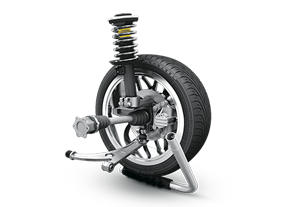Ball Joint Replacement
Upper and lower ball joints are designed to fit snugly inside a lubricated casing. If the casing loses lubrication, dries out, or the linkage becomes loose, wheel alignment may be affected. A loose ball joint can also result in suspension noise and uneven tire wear. Because ball joints act as the link between the wheels and other suspension components, a bad joint can conflict with normal steering capabilities. In extreme cases, a worn ball joint that fails may fall out of its casing and cause a collapse of the suspension system. Clunking sounds, poor handling, and unnatural pulling are all signs of bad ball joints. In some cases, ball joints may require replacements. If you plan on avoiding a ball joint failure, be sure to consult your owner’s manual for the maximum allowable wear on your suspension system’s ball joints. Our replacement ball joints will restore full functionality to your suspension system.
Inner Tie Rod & Outer Tie Rod Replacement
Difficult, erratic, and unexpected steering are signs that your tie rods—inner, outer, or both—might need to be replaced. One indication that your tie rods may be loose is excessive and uneven tire wear. Vibrations and clunking noises emanating from the front of your vehicle are another sign. Steering that pulls or refuses to return to center are also signals that your inner and outer tie rods should be checked and possibly replaced by a member of our service staff. Wheels out of alignment may be signs of bad inner or outer tie rods. As an outer tie rod fails, the toe changes direction and the steering begins to pull. Clicking or grinding noise under your front wheels are other signs of bad tie rods. If you experience any warning signs of a malfunctioning tie rod, give us a call or contact us online, and allow our service staff to determine if your steering system requires tie rod replacements.
Shocks Replacement
Replacing shocks can maximize the performance of your entire suspension system. The components in your suspension system interact and depend on each other. Shock absorbers and brakes work together to help your vehicle stop as soon as possible upon engaging the brake pedal. Worn shocks mean your vehicle is less likely to stop exactly when and where you want. In fact, bad shocks can increase your stopping distance by up to 10 feet. Worn shock absorbers will cause your vehicle to dive when braking. With a set of bad shocks, you may experience problems like bounce, body roll, sway, and other unexpected movements in your suspension system. Healthy shocks improve braking and handling, making your vehicle easier to control. Replacing front and rear shocks as necessary will help promote a safe road for everyone.
Struts Replacement
Worn struts increase braking distance and increase body roll, sway, and bounce rate. The bounce test, wherein you bounce on each corner of your vehicle a few times, is a good way to determine whether or not you need to schedule a strut replacement. If your vehicle bounces and settles, your struts are operating as they should. If your vehicle continues to bounce, you should seek to replace the struts on your suspension system as soon as possible. Other signs that your struts need to be replaced include excessive brake dive, acceleration squat, body roll or sway, and unusual tire wear patterns. Unusual noise from struts may also indicate that the spring seat or strut bearing requires a replacement. If you experience any of the above signs of worn struts, contact us immediately. Having your struts replaced will improve braking, handling, and the overall controllability of your vehicle.
Suspension Inspection
Knowing how to identify steering and suspension issues will help you determine when to schedule an inspection. Over time, the components of your suspension system, like coil springs, shock absorbers, struts, shocks, tie rods, ball joints, and sway bar links, can weaken and malfunction, thereby decreasing your ability to maintain control of your vehicle. Signs of an impending suspension inspection include leaking shocks or struts. Nose-dives when braking and bottoming out during bumps are also signs of a problem with your vehicle’s suspension system. If you begin to experience driving irregularities like bouncing, swaying, or unusual stiffness, contact us today for an inspection of your steering and suspension system. Besides being aware of the signs and symptoms of a worn suspension system, be sure to consult your owner’s manual when determining maintenance schedules and intervals for inspections of your vehicle’s suspension system.
Sway Bar Link Replacement
Because sway bar links are responsible for transferring the force of motion from the wheels to the sway bar and to the rest of the suspension system, if a sway bar end link is damaged, the controllability of your vehicle and the safety of your passengers are at risk. While some sway bar links have bushing that can be replaced, other sway bar links require replacements upon wearing out. Warning signs of a broken or bad sway bar link include clunks and squeaks. Over-steering or excessive lean through turns are also symptoms of worn sway bar links, but they can also be signs of larger problems with your vehicle’s suspension system. Do not let symptoms of bad sway bar links or other suspension components go untreated. Little problems with suspension systems have the tendency to turn into larger problems and more expensive repairs if not repaired or replaced. If you experience any of the above symptoms, allow our service staff to determine if a sway bar link replacement is right for you.



